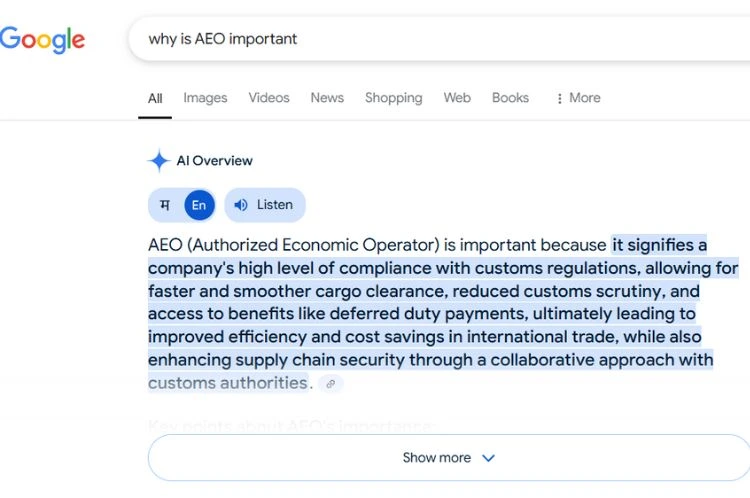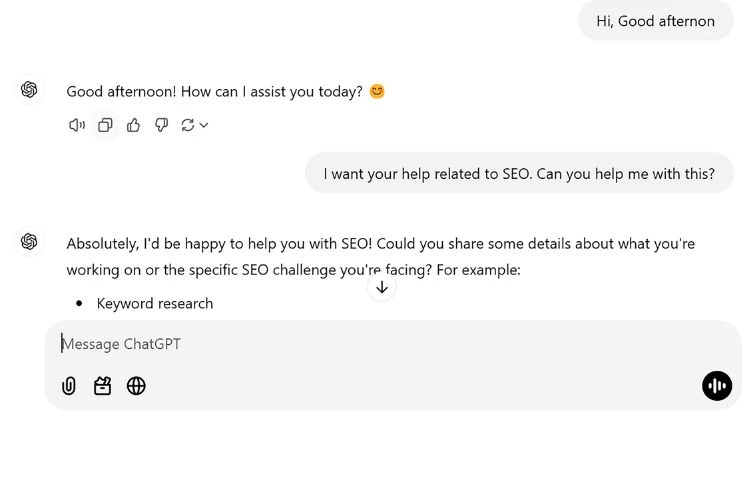Our search behaviour is continuously evolving. It is shifting from traditional keyword-based queries to more conversational and direct interactions. This evolution is the direct result of the introduction and incorporation of artificial intelligence.
While SEO still remains the cornerstone of driving organic traffic, AEO has emerged as a critical tool for brands aiming to deliver instant, concise answers to user queries. This blog explores the key differences, goals, and synergies between SEO and AEO and how businesses can leverage both to boost visibility and authority.
A Brief Overview of SEO
Search Engine Optimisation (SEO) focuses on improving a website’s visibility on search engine results pages (SERPs). It encompasses a variety of techniques, including:
- On-Page SEO: Optimising content, meta tags, and internal links.
- Off-Page SEO: Building backlinks and establishing domain authority.
- Technical SEO: Enhancing site speed, mobile responsiveness, and crawlability.
SEO’s primary objective is to rank higher in search results, increase organic traffic, and ultimately drive conversions. Its success relies on understanding search engine algorithms and aligning content strategies with user intent.
What is AEO?
AEO stands for Answer Engine Optimisation, but before we talk about AEO, let’s first understand what an Answer Engine is.
Answer engines are AI-powered systems designed to deliver direct and immediate answers to user queries. Unlike traditional search engines, which provide a list of links and websites for users to explore, answer engines aim to resolve user intent directly within the interface. Examples include:
Google’s Featured Snippets: A snippet is the highlighted answer for a Google search before a list of websites appears. Types of snippets include paragraph snippets, table snippets, list snippets, and video snippets.

Voice Assistants: AI tools like Siri, Alexa, and Google Assistant providing spoken responses. They simplify our work, provide precise answers, and are easily accessible to common people.

Generative AI Bots: Generative AI bots like ChatGPT and Gemini take AI to a whole new level. They not only give precise answers; they can also interact with us like real humans, having conversations and discussions.

How to Optimize for Answer Engines (AEO)?
Answer Engine Optimisation (AEO) involves structuring content to make it easily understandable by AI and natural language processing (NLP) systems. Key strategies include:
Schema Markup: Using structured data to help search engines understand content context.
Concise Content: Crafting precise answers to common queries. Answering questions on platforms like Reddit and Quora.
Focus on Conversational Queries: Optimising for long-tail and voice search keywords. For example, long-tail keywords like ‘best e-commerce platforms for small businesses’ are now replacing short-tail keywords like ‘e-commerce’.
Enhanced UX: Ensuring fast-loading, mobile-friendly pages. Aim that your website loads in under 3 minutes, or people will abandon it.
By addressing the specific intent of users, AEO helps brands secure featured positions in zero-click results, where users get answers without needing to click through to a website.
Key Differences Between SEO and AEO
| Parameter | SEO | AEO |
| Primary Objective | Increase website traffic via rankings | Provide direct answers to user queries |
| Query Intent | Navigational and transactional | Informational and conversational |
| Technical Elements | Keywords, backlinks, meta tags | Schema markup, structured data |
| Examples | Blog posts, product pages | Featured snippets, voice search results |
Goal of SEO vs. Goal of AEO
Goal of SEO
The primary goal of Search Engine Optimisation (SEO) is to attract and convert users by improving the visibility of a website in search engine results pages (SERPs). It aims to drive organic traffic by optimising various elements such as keywords, content quality, meta tags, backlinks, and user experience. Higher rankings in SERPs increase exposure and reach, ultimately converting visitors into customers or leads.
Goal of AEO
Answer Engine Optimisation (AEO) focuses on establishing authority and user trust by delivering accurate and immediate answers directly within the search interface. The goal of AEO is to provide precise and reliable information in response to user queries, often through featured snippets, voice search responses, and other answer boxes. This enhances the user experience by offering quick resolutions without requiring additional clicks, building trust and credibility.
Content Structure: SEO vs. AEO
SEO Content
- Long-form articles targeting broad topics.
- Keyword optimisation to rank for specific search terms.
- Detailed explanations and comprehensive coverage.
AEO Content
- Short, concise answers to specific queries.
- Use of bulleted lists, tables, and structured data for clarity.
- Optimised for voice search and conversational intent.
User Experience and Intent: SEO vs. AEO
SEO
SEO enhances user experience by:-
- Ensuring fast-loading pages
- Intuitive navigation
- Mobile compatibility
By optimising these elements, SEO aims to create a seamless and enjoyable browsing experience that keeps users engaged and encourages them to explore more content on the site.
AEO
AEO focuses on understanding and fulfilling user intent immediately, often through conversational AI and voice interfaces. By providing quick and accurate answers to user queries, AEO aims to meet users’ needs directly within the search interface, reducing the need for additional clicks and enhancing overall satisfaction.
How to Combine SEO with AEO to Boost Brand Visibility
While SEO and AEO are technically different, they both work hand in hand. SEO experts believe that AEO can be considered a part of SEO, and if you are treating them differently, your strategies and methods are incorrect. Here’s how you can boost your brand’s visibility by combining SEO with AEO:
- Leverage Structured Data: Implement schema markup to make content eligible for featured snippets and other rich results.
- Balance Content Length: Use long-form content to rank on SERPs while creating concise answers for AEO, like adding bullet points or tables.
- Optimise for Voice Search: Identify and target conversational queries relevant to your industry.
- Focus on User Intent: Align content with both navigational and informational search needs.
Benefits of Combining SEO and AEO
- Enhanced Visibility: By combining SEO and AEO, you can appear in both traditional search rankings and zero-click results. This dual presence ensures that your content is accessible to users regardless of whether they prefer clicking through to a website or getting quick answers directly from the search results.
- Stronger Authority: Positioning your brand as a trusted source of information is easier when you leverage both SEO and AEO. High search rankings build credibility, while delivering precise answers directly within search results reinforces your authority and reliability in the eyes of users.
- Higher Engagement: Combining SEO and AEO satisfies users with immediate answers and comprehensive resources. While AEO addresses their immediate queries, SEO draws them into your site, where they can engage more deeply with your content, leading to longer session durations and increased interaction.
- Increased Traffic: Using both strategies drives clicks from search engine results pages (SERPs) while capturing attention through direct answers. SEO attracts organic traffic by improving search rankings, and AEO ensures that even users who prefer quick answers are exposed to your brand, potentially leading to more visits and conversions over time.
Benefits of SEO and AEO in Different Industries
| Industry | SEO Benefits | AEO Benefits |
| E-commerce | – Increased organic traffic from high search rankings.
– Better product visibility leading to higher sales. |
– Quick answers to product queries improving user satisfaction.
– List of best selling products |
| Finance | – Higher visibility for financial services and advice, attracting potential clients.
– Improved credibility through authoritative content and backlinks. |
– Simplified answers to common financial questions enhancing user trust.
– Quick access to information about services and products. |
| Banking | – Increased traffic to banking services and product pages.
– Enhanced reputation through high-quality, informative content. |
– Quick, accurate answers to banking queries like creating a new account.
– Efficient handling of frequently asked questions through voice search and AI interfaces. |
| Technology | – Higher search engine rankings for tech products and solutions, driving more traffic.
– Improved brand authority through technical content and backlinks. |
– Immediate answers to technical queries improving user experience.
– Quick access to troubleshooting steps and product information through voice search. |
Conclusion
The future of search optimisation lies in balancing SEO and AEO to meet evolving user expectations. By understanding the unique strengths of each strategy and combining their approaches, brands can enhance visibility, authority, and user satisfaction. In a world that prioritizes instant gratification, brands that embrace both SEO and AEO will maintain a competitive edge and secure long-term success in the competitive digital landscape.
If you are looking to scale your business or improve its visibility, you can contact Sudha Solutions. Our services include SEO, content marketing, performance marketing, retention marketing, and more. Our client list includes brands like Manyawaar, Van Heusen, and Vodafone. Visit Sudha Solutions to know more about our services.
Contact Sudha Solutions today to strategize your next eCommerce customer retention journey!




